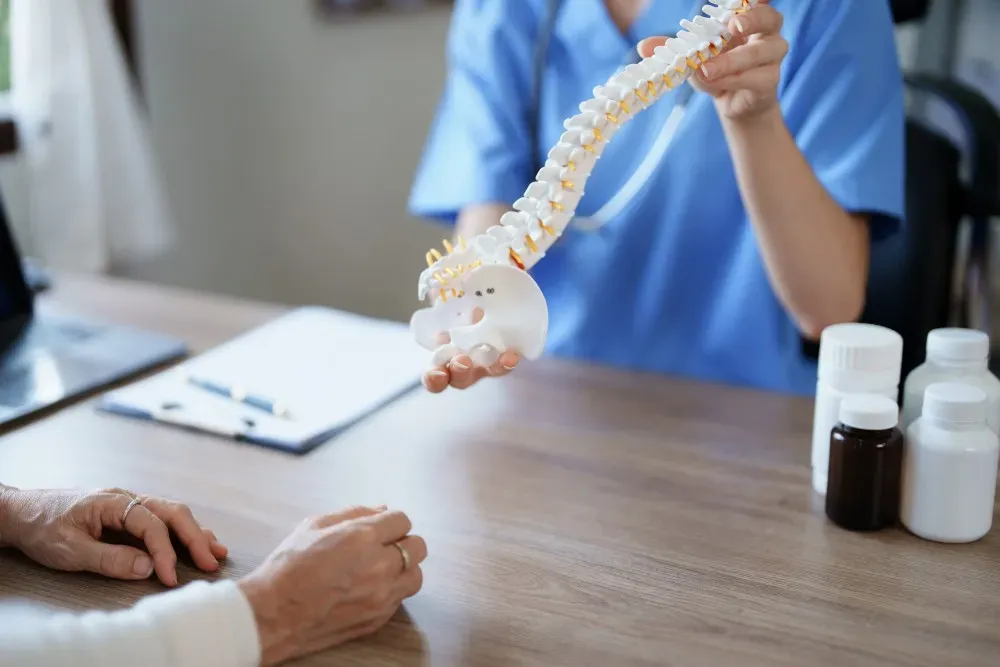Neurosurgery & Orthopedic Surgeons in Jacksonville

What is a Rotator Cuff Injury?
Rotator cuff injuries and tears can cause significant shoulder pain and make everyday activities like getting dressed, opening doors and carrying bags difficult. At night, laying on painful shoulder injuries can cause you to lose sleep.
Rotator cuff injuries and tears can cause significant shoulder pain and make everyday activities like getting dressed, opening doors and carrying bags difficult. At night, laying on painful shoulder injuries can cause you to lose sleep.
Approximately 2 million people in the U.S. report a shoulder cuff problem to their doctor every year. Keep reading to learn more about common shoulder injuries and when to seek treatment.
THE FUNCTION OF THE ROTATOR CUFF
The rotator cuff includes the group of tendons and muscles originating from the shoulder blade that surround, protect and stabilize the shoulder joint. These supportive tissues keep the head of the upper arm bone locked into the shoulder socket and they facilitate movement and rotation of the arm and shoulder.
TYPES OF INJURIES
There are 4 types of injuries that affect the rotator cuff tendons:
- Tendinitis. Tendinitis develops when a tendon in the rotator cuff becomes inflamed from overuse or an acute injury.
- Bursitis. Bursitis develops when the bursa sac in the rotator cuff becomes inflamed from overuse or an acute injury. The bursa is a fluid-filled sac that sits between the shoulder blade and the tendons. It lubricates the joint to facilitate movement and prevents the tendons and bone from rubbing against each other.
- Strain. A strain develops when a tendon becomes overstretched.
- Tear. A tear develops when a tendon tears either partially or completely. A tear may occur from a single traumatic incident like lifting a heavy object. Or it may occur after the tendon has been weakened from repetitive overuse, a strain or inflammation.
CAUSES AND RISK FACTORS
Rotator cuff injuries are caused by:
- Natural wear and tear over time
- Traumatic injuries from a fall, car crash or sports collision
- Repetitive overhead motions and shoulder movements
Risk factors for developing shoulder injuries include:
- Age. Adults over the age of 40 are more likely to develop injuries caused by natural wear and tear on the joints.
- Playing sports and weightlifting. Athletes and weightlifters are more likely to develop acute injuries from sports accidents or lifting heavy loads. Athletes are also more likely to develop injuries from repetitive use. Sports that require a lot of shoulder movement include tennis, rowing, wrestling and baseball.
- Having a physically demanding job. Workers who have physically demanding jobs are more likely to develop injuries from repetitive use. Professions that require a lot of shoulder movement include construction, carpentry, painting and window cleaning.
SYMPTOMS
If you develop a rotator cuff injury, you might experience the following symptoms:
- Shoulder pain, aching and tenderness
- Pain while sleeping on the injured shoulder
- Stiffness
- Loss of motion, with difficulty performing certain movements like reaching overhead or reaching behind your back
- Arm weakness
If you experience any of the above symptoms, seek medical care and treatment. Ignoring the signs of injury increases your risk of developing a more serious injury, like a rotator cuff tear. If you suffer a tendon tear, you will know immediately, because a tear causes significant pain.
DIAGNOSIS AND TREATMENT
To make a diagnosis, your doctor will take a medical history, perform a physical exam and ask about any recent accidents or injuries. He or she will use imaging studies like an MRI to study the tendons and muscles in your shoulder. MRI scans can help identify soft tissue damage and tendon tears.
If identified and treated early, many rotator cuff injuries heal with conservative treatments. A full recovery will probably take several weeks. Your doctor may recommend the following options.
1.) Rest. Refrain from doing activities that place stress or strain on the rotator cuff. Continued aggravation of the injury can cause a tendon to tear. Ice packs placed over the injured area can help soothe pain and reduce inflammation.
2.) Pain medications. Over-the-counter NSAIDs can help relieve shoulder pain and inflammation.
3.) Cortisone injections. A cortisone injection directly into the injured joint can reduce pain, irritation and inflammation. The effects of injections are temporary and you’ll only be allowed to receive a certain number of injections a year.
4.) Physical therapy and stretching. Physical therapy exercises and stretches can help strengthen the shoulder muscles and improve range of motion in the joint.
Left untreated, rotator cuff injuries may worsen and cause long-term pain, weakness, loss of motion and permanent joint damage. Failing to follow conservative recommendations when you have a minor injury can cause the damage to progress and require surgical repair.
SURGICAL TREATMENT
If your injury is severe, causes significant pain or doesn’t respond to conservative treatments, you may need surgery. There are several surgical options available for rotator cuff injuries, including:
- Tendon repair. Tendon repair can be performed as a minimally invasive arthroscopic procedure or an open surgery. Minimally invasive procedures require smaller incisions and less recovery time than open surgeries, but the size and severity of your injury may prevent minimally invasive surgery from being a viable option.
- Tendon transfer. If the tendon damage is significant, a nearby tendon may be transferred to replace the injured one.
- Shoulder replacement. Very severe injuries may require total shoulder replacement with an artificial joint.
If surgery is a treatment option for you, your doctor will walk you through the choices available and the pros and cons of each.
PREVENTION
In many cases, rotator cuff injuries are highly preventable with good care. Here are some things you can do at home to protect the rotator cuff tendons and reduce your risk of injury.
1.) Perform shoulder-strengthening exercises. Strengthen the muscles in and around your shoulders to protect the rotator cuff and encourage full range of motion in the shoulder joint. A physical therapist can teach you exercises and stretches that promote rotator cuff functionality.
2.) Learn proper technique. Improper technique for heavy lifting in sports, weight training or physically demanding jobs is a leading cause of rotator cuff injuries. During strength training, learn the correct form before lifting heavy weights and advance weight loads slowly and carefully.
3.) Rest and ice. If you’re engaged in a job, sport or hobby that involves repeated overhead lifting or shoulder movements, rest frequently. Rest takes the stress off your tendons. If you do experience shoulder pain, use ice packs to reduce inflammation in the area.
INTEGRITY SPINE AND ORTHOPEDICS TREATS SPINE AND JOINT CONDITIONS
At Integrity Spine and Orthopedics, we specialize in treating a wide range of spine, joint and musculoskeletal conditions. Our board-certified team of doctors have training and expertise in orthopedic care, pain management and minimally invasive procedures for acute and chronic back and joint pain. Our goal is to help you receive the care and treatment you need to get you back up and doing the activities you love after an injury.
Call us today at 904-456-0017 or fill out an online contact form to schedule an appointment. We also offer free MRI reviews to qualified patients.




